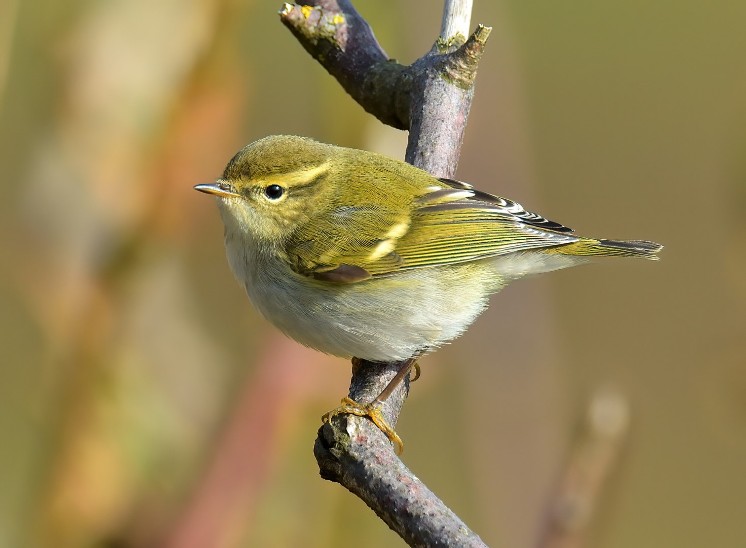Yellow-browed Warbler on Arran
Reports

On Tuesday 11 October in the morning, a Yellow-browed Warbler was seen and heard in Sliddery by Chris Southall. It was the loud and distinctive call note tsoeest that first caught Chris’s attention. Although Chris had poor views of the bird, the bird was very vocal, and it remained in the area for about twenty minutes. There was no sign of it after nine o’clock. Yellow-browed Warbler is a small, active warbler with greenish upperparts, white underparts, distinct pale yellowish eyebrow, and distinct pale wingbars. The upper wingbar is shorter and less distinct. It is similar in size to a Goldcrest. The yellow 'eyebrow' is distinctive, as is the call. Dennis Morrison’s illustrative photograph captures its physical features well.
There have only been two previous Arran records of Yellow-browed Warbler. The first one was in Kilmory in December 1995 and the second in Whiting Bay in December 2007.
Where have they come from? Yellow-browed Warblers breed across Russia, extending east from the Urals as far as Kamchatka and south to Afghanistan, northern India and the Sea of Japan. In autumn most of the breeding population migrates through north-eastern China, to the species’ winter quarters, which extend from central Nepal south to the Malay Peninsula. The breeding areas are vacated in August and September and birds arrive in the winter range from mid-October, departing again in late March and early April. In the autumn and in increasing numbers, some Yellow-browed Warblers are moving into western Europe including Britain.
The middle fortnight of October is the peak time for Yellow-browed Warbler arriving in Britain, but the first birds often turn up as early as mid-September and the last as late as December. Records are mostly along the east coast south to Norfolk and along the south coast from Kent to Scilly. A few birds are recorded inland or from western counties. In Scotland, the Northern Isles and east coast sites get most of the records, but the species also reaches the Outer Hebrides most years.
In Britain, Yellow-browed Warbler was recorded only a handful of times before1958. The following years saw a remarkable and unexpected increase. By the 1970s, about 70 individuals appeared each year, and by the early 2000s it was more than 400 a year. Records kept on rising, with more than 800 in 2003 and an incredible 2,000 in 2017. And yet these are birds that should be on their way south to winter in south-east Asia, in places such as Thailand and Singapore.
So why are so many Yellow-browed Warblers now reaching Britain each autumn? Many theories have been proposed. Perhaps with milder winters we are witnessing a subtle shift in wintering range, with regular dispersal having become successful and leading to overwintering and a subsequent return migration. Maybe the birds we are seeing have become genetically programmed to migrate this way, with Britain and Europe now on a new migration path and a new winter range slowly evolving. Whatever the reason, there is no doubt that this warbler, one of our smallest scarce visitors, is welcome whenever it appears.